Are trying to avoid fleas this flea season? Are you wondering what plants repel fleas? Whether you have furry friends or are just looking to reduce garden pests, you definitely want to keep these unwanted pests away!
This site contains affiliate links. If you make a purchase using one of these links, I may earn a commission. Please click here for more information about cookies collected and our privacy policy.
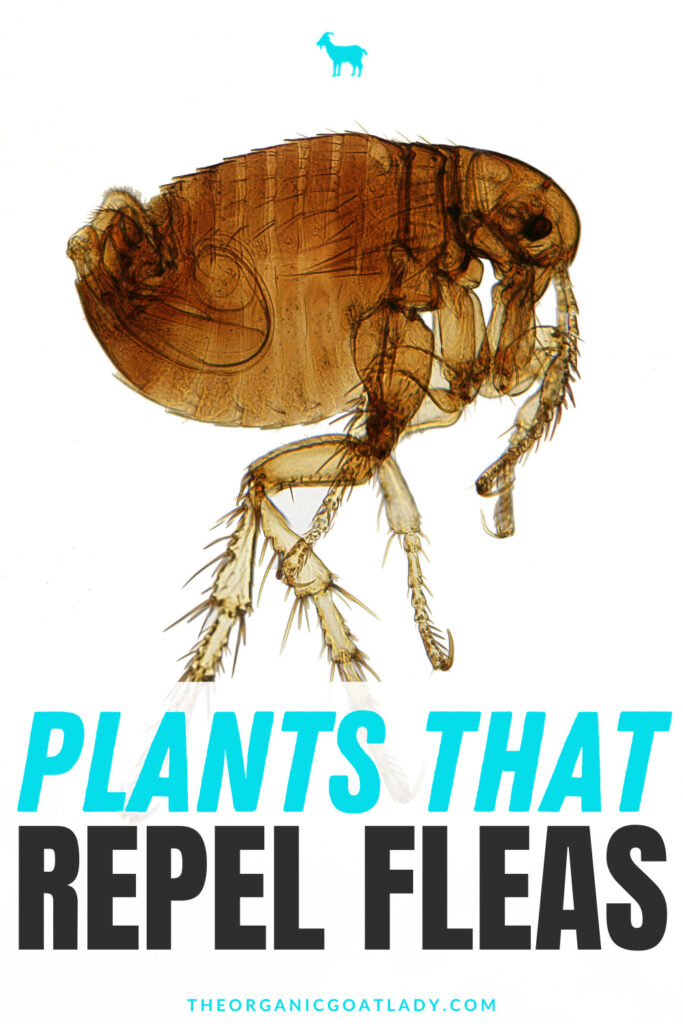
What plants repel fleas?
Several plants are known for their ability to repel fleas and other insects due to the natural compounds they produce. While these plants can help reduce the presence of fleas, it’s important to note that they may not provide complete protection, and you should still use other flea control methods, especially if you have pets.
Flea Populations
Fleas are small, wingless insects that belong to the order Siphonaptera. They are ectoparasites, meaning they live on the outside of their host’s body and feed on the blood of mammals and birds. Fleas are known for their ability to jump long distances relative to their size, thanks to their powerful hind legs.
Here are some key characteristics and facts about fleas:
1. Size: Adult fleas are typically about 1 to 4 millimeters in length, depending on the species. They are flattened from side to side, which allows them to move easily through the fur or feathers of their hosts.
2. Lifecycle: Fleas undergo complete metamorphosis, which includes four stages: egg, larva, pupa, and adult. The lifecycle can vary in duration depending on environmental conditions but generally takes a few weeks to several months.
3. Feeding: Fleas feed exclusively on the blood of their hosts. They use specialized mouthparts to pierce the host’s skin and draw blood. Flea bites can be itchy and uncomfortable for the host, often causing skin irritation and allergic reactions.
4. Hosts: Different species of fleas have specific host preferences, although some fleas are known to infest multiple host species. For example, the cat flea (Ctenocephalides felis) primarily infests cats and dogs but can also infest other mammals, including humans.
5. Disease Vectors: Fleas can transmit diseases to their hosts. The most famous example is the bubonic plague, which is caused by the bacterium Yersinia pestis and was responsible for several historic pandemics. Fleas can also transmit other diseases and parasites.
6. Lifecycle in the Environment: Flea larvae are usually found in the environment (e.g., in carpet fibers, bedding, or soil) rather than on the host. They feed on organic matter, including dried blood excreted by adult fleas. Pupation occurs in a cocoon, and adult fleas emerge when they detect a nearby host.
7. Control: Controlling flea infestations typically involves a combination of measures, including treating pets with flea prevention products, vacuuming and cleaning the indoor environment, and using insecticides as necessary. Integrated pest management (IPM) strategies are often employed to effectively manage flea populations.
Fleas can be a nuisance and a health concern for both humans and animals due to their ability to transmit diseases and cause discomfort. Preventing and treating flea infestations in pets and homes is important for the well-being of both pets and their owners.
Flea-Repelling Plants
Here are some types of plants that are believed to repel fleas:
1. Lavender (Lavandula spp.): Lavender, with it’s pretty purple flowers, has a pleasant fragrance that humans love but fleas detest.

Here’s how you can use lavender plants to help repel fleas:
1. Plant Lavender in Your Garden: One of the most effective ways to use lavender to repel fleas is by planting lavender plants in your garden or outdoor living spaces. This not only adds to a beautiful garden but also helps deter fleas from the area. Lavender is relatively easy to grow and thrives in well-drained soil and full sun making it a great addition to garden plants.
2. Indoor Pots or Planters: You can also grow lavender in pots or planters indoors, especially in areas where your pets spend a lot of time. Place these pots near entry points, windows, or any areas where fleas may enter your home. The lavender’s fragrant flowers can help deter fleas from coming inside.
3. Lavender Sachets: Dry lavender flowers and create sachets to place in your pet’s bedding, closets, drawers, or other areas where fleas may hide. These sachets emit a pleasant lavender scent that repels fleas and keeps your living spaces smelling fresh.
4. DIY Lavender Spray: Make a homemade flea-repelling spray using lavender essential oil. Mix a few drops of lavender essential oil with water or plant enzymes in a spray bottle and lightly mist your pet’s bedding, carpets, and other areas prone to flea infestation. Be sure to shake the bottle before each use as the oil will separate from the water. And always be sure to follow proper dilution ratios when using essential oils for pets. You can find everything you need to know in the Essential Oil for Pets section of the Essential Oil Academy Course.
5. Lavender Pet Collars: Consider attaching a small lavender sachet or a few dried lavender flowers to your pet’s collar. Make sure it’s secure and doesn’t pose any choking hazards. This can provide your pet with a natural flea-repelling aroma.
6. Lavender Oil Diffuser: Use a lavender essential oil diffuser in your home to release the soothing fragrance of lavender. This can help create a flea-discouraging atmosphere indoors.
While lavender is a natural and safe way to help repel fleas, it may not be the sole solution in severe flea infestations. Combining lavender with other flea prevention and control methods, such as regular grooming, cleaning, and pet-specific flea products, is often necessary for comprehensive flea management. Additionally, consult with your veterinarian for advice on the most effective flea control strategies for your specific pet’s needs.
2. Mint (Mentha spp.): Mint plants, including various mint varieties in the Mentha genus like peppermint (Mentha × piperita) and spearmint (Mentha spicata), are known for their aromatic properties and can be used to help repel fleas.
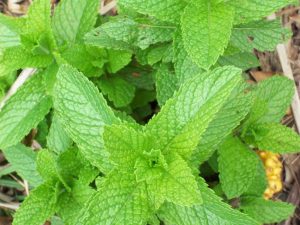
Here’s how you can use mint plants to deter fleas:
1. Plant Mint in Your Garden: Mint is relatively easy to grow and can be an attractive addition to your garden or outdoor living spaces. Plant mint around the perimeter of your yard, near entry points to your home, or in areas where your pets frequent. The strong scent of mint can help repel fleas and other insects from these areas.
2. Indoor Pots or Planters: You can also cultivate mint plants in pots or planters indoors. Place these containers near windows or doors, where fleas might enter your home. Mint’s fragrance can act as a natural barrier to deter fleas from coming inside.
3. DIY Mint Spray: Make a homemade flea-repelling spray using mint leaves. Crush fresh mint leaves and steep them in boiling water. Allow the mixture to cool, strain out the leaves, and then transfer the liquid to a spray bottle. Lightly mist your pet’s bedding, carpets, and other areas where fleas may hide. Refresh the spray as needed.
4. Mint Sachets: Create sachets using dried mint leaves or mint essential oil. Place these sachets in your pet’s bedding, closets, drawers, or other areas where you want to deter fleas. The scent of peppermint oil can help repel fleas and keep your living spaces smelling fresh.
5. Mint Pet Collars: Attach a small sachet of dried mint leaves or a few drops of mint essential oil to your pet’s collar. Make sure it’s secure and safe for your pet to wear. This can provide a natural flea-repelling aroma.
6. Mint-Infused Cleaning Products: Infuse your homemade cleaning products with mint leaves or mint essential oil. When cleaning pet-related areas or your home in general, the minty scent can help repel fleas.
Keep in mind that while mint can be a natural and safe way to help deter fleas, it may not be a standalone solution for severe flea infestations. Combining mint with other flea prevention and control methods, such as regular pet grooming, cleaning, and pet-specific flea products, is often necessary for comprehensive flea management. Additionally, consult with your veterinarian for advice on the most effective flea control strategies for your specific pet’s needs.
3. Rosemary (Rosmarinus officinalis): Rosemary (Rosmarinus officinalis) is an aromatic herb known for its culinary uses as well as its potential to repel fleas and other insects.
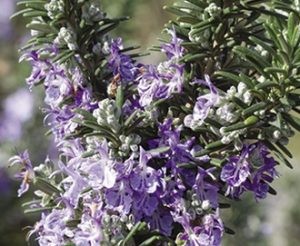
Here’s how you can use rosemary plants to help deter fleas:
1. Plant Rosemary in Your Garden: Rosemary is a hardy and versatile herb that can be a beautiful addition to your herb garden. Plant rosemary bushes around outdoor seating areas, near entry points to your home, or in areas where your pets spend time. The strong scent of rosemary can help repel fleas and other pests.
2. DIY Rosemary Flea Spray: You can make a homemade flea-repelling spray using rosemary leaves. Follow these steps:
– Boil water and pour it over a handful of fresh rosemary leaves or a few tablespoons of dried rosemary.
– Allow the mixture to steep and cool.
– Strain out the leaves, and then transfer the liquid to a spray bottle.
– Lightly mist your pet’s bedding, carpets, and other areas prone to flea infestation. Repeat as needed.
3. Rosemary Sachets: Create sachets using dried rosemary leaves or rosemary essential oil. Place these sachets in your pet’s bedding, closets, drawers, or other areas where you want to deter fleas. The aromatic qualities of rosemary can help repel fleas and keep your living spaces smelling fresh.
4. Rosemary-Infused Cleaning Products: Infuse your homemade cleaning products with rosemary leaves or rosemary essential oil. When cleaning pet-related areas or your home in general, the rosemary scent can help repel fleas.
5. Indoor Pots or Planters: If you’d like to have rosemary indoors, you can grow it in pots or planters near windows or doors. This can help create a natural barrier to deter fleas from entering your home.
While rosemary is a natural and safe way to help repel fleas, it may not be the sole solution for severe flea infestations. Combining rosemary with other flea prevention and control methods, such as regular pet grooming, cleaning, and pet-specific flea products, is often necessary for comprehensive flea management. Additionally, consult with your veterinarian for advice on the most effective flea control strategies for your specific pet’s needs.
Flea Repellent Plants
4. Pennyroyal (Mentha pulegium): Pennyroyal (Mentha pulegium) is part of the mint family known for its strong fragrance and potential as a natural flea repellent. However, it’s essential to exercise caution when using pennyroyal, as it contains a toxic compound called pulegone, which can be harmful to pets and humans if ingested in large quantities.
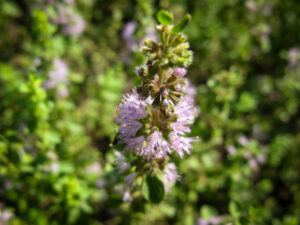
While pennyroyal has been historically used for flea control, it’s crucial to use it sparingly and avoid direct contact with pets and children.
Here’s how you can use pennyroyal plants to help repel fleas:
1. Plant Pennyroyal in Your Garden: If you choose to grow pennyroyal, plant it in your garden or outdoor living spaces. Plant it strategically, such as near entry points to your home or in areas where your pets spend time, but ensure it’s not accessible to pets or children.
2. Pennyroyal Sachets: Create sachets using dried pennyroyal leaves or pennyroyal essential oil. Place these sachets in closets, drawers, or other areas where you want to deter fleas. Make sure they are out of reach of pets and children.
3. Pennyroyal Oil Spray: Make a diluted pennyroyal oil spray by mixing a few drops of pennyroyal essential oil with water. Spray this mixture lightly in areas where you want to repel fleas, but avoid spraying it directly on pets or in areas where pets frequent. Ensure proper ventilation when using pennyroyal oil.
4. Use with Caution: Exercise extreme caution when using pennyroyal or other toxic plants around pets and children. Keep pennyroyal plants and products out of their reach. Avoid using pennyroyal directly on pets or their bedding, as it can be toxic to them.
5. Consult a Veterinarian: Before using pennyroyal or any natural flea repellent, consult with your veterinarian to ensure that it is safe and appropriate for your specific pets. Some pets may be more sensitive or prone to adverse reactions.
Due to the potential toxicity of pennyroyal, many experts recommend using alternative methods to repel fleas that are safer for both pets and humans. If you are concerned about flea infestations, it’s best to consult with your veterinarian to determine the most effective and safe flea control strategies for your pets and home.
5. Lemon Balm (Melissa officinalis): Lemon balm (Melissa officinalis), a member of the mint family, is a fragrant herb known for its pleasant lemony scent and various uses, including its potential to repel fleas and other insects.
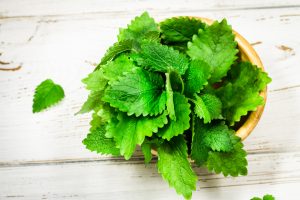
Here’s how you can use lemon balm plants to help deter fleas:
1. Plant Lemon Balm in Your Garden: Lemon balm is a hardy and easy-to-grow herb that can thrive in your garden or outdoor living spaces. Plant it around the perimeter of your yard, near entry points to your home, or in areas where your pets frequent. The lemony aroma of lemon balm can help repel fleas and other pests.
2. Indoor Pots or Planters: You can also cultivate lemon balm in pots or planters indoors, especially in areas where your pets spend time. Place these containers near windows or doors to create a natural barrier to deter fleas from entering your home.
3. Lemon Balm Sachets: Create sachets using dried lemon balm leaves or lemon balm essential oil. Place these sachets in your pet’s bedding, closets, drawers, or other areas where you want to deter fleas. The lemony scent of lemon balm can help repel fleas and keep your living spaces smelling fresh.
4. DIY Lemon Balm Flea Spray: You can make a homemade flea-repelling spray using lemon balm leaves. Follow these steps:
– Boil water and pour it over a handful of fresh lemon balm leaves or a few tablespoons of dried lemon balm.
– Allow the mixture to steep and cool.
– Strain out the leaves, and then transfer the liquid to a spray bottle.
– Lightly mist your pet’s bedding, carpets, and other areas prone to flea infestation. Repeat as needed.
5. Lemon Balm Pet Collars: Attach a small sachet of dried lemon balm leaves or a few drops of lemon balm essential oil to your pet’s collar. Make sure it’s secure and safe for your pet to wear. This can provide a natural flea-repelling aroma.
While lemon balm is a natural and safe way to help repel fleas, it may not be the sole solution for severe flea infestations. Combining lemon balm with other flea prevention and control methods, such as regular pet grooming, cleaning, and pet-specific flea products, is often necessary for comprehensive flea management. Additionally, consult with your veterinarian for advice on the most effective flea control strategies for your specific pet’s needs.
6. Catnip (Nepeta cataria): Catnip (Nepeta cataria) is well-known for its attractive effects on cats but also has the potential to repel fleas and other insects.
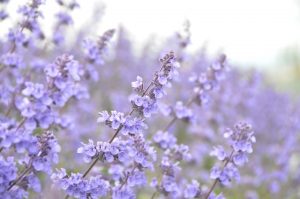
Here’s how you can use catnip plants to help deter fleas:
1. Plant Catnip in Your Garden: Catnip is a hardy and easy-to-grow herb that you can cultivate in your garden or outdoor living spaces. Plant catnip near entry points to your home or in areas where your pets spend time. The aromatic qualities of catnip can help repel fleas and other pests. Of course if you are also trying to repel stray cats you will want to avoid this plant. You can find the Best Plants to Repel Cats here.
2. Indoor Pots or Planters: You can also grow catnip in pots or planters indoors. Place these containers near windows or doors, where fleas might enter your home. Catnip can create a natural barrier to deter fleas from coming inside.
3. Catnip Sachets: Create sachets using dried catnip leaves and place them in your pet’s bedding, closets, drawers, or other areas where you want to deter fleas. Catnip sachets can help repel fleas and keep your living spaces smelling fresh.
4. DIY Catnip Flea Spray: Make a homemade flea-repelling spray using catnip leaves. Follow these steps:
– Boil water and pour it over a handful of fresh catnip leaves or a few tablespoons of dried catnip.
– Allow the mixture to steep and cool.
– Strain out the leaves, and then transfer the liquid to a spray bottle.
– Lightly mist your pet’s bedding, carpets, and other areas prone to flea infestation. Repeat as needed.
5. Catnip Pet Toys: Catnip-infused pet toys are commercially available. These toys contain dried catnip leaves, which can attract and entertain cats while potentially repelling fleas.
6. Catnip-Infused Pet Bedding: Consider using catnip-infused pet bedding. Some pet bedding products are designed to release the scent of catnip, which may help repel fleas and provide comfort for your pets.
While catnip is a natural and safe way to help repel fleas, it may not be the sole solution for severe flea infestations. Combining catnip with other flea prevention and control methods, such as regular pet grooming, cleaning, and pet-specific flea products, is often necessary for comprehensive flea management. Additionally, consult with your veterinarian for advice on the most effective flea control strategies for your specific pet’s needs.
7. Citronella plants (Cymbopogon nardus and Cymbopogon winterianus): Citronella plants are known for their strong, lemony scent, which is often used to repel mosquitoes and other flying insects. While citronella is primarily associated with mosquito repellent, its fragrance can also help deter fleas and ticks to some extent.
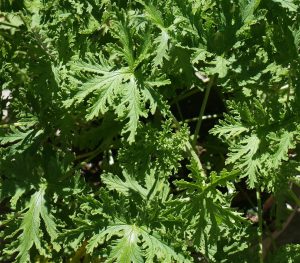
Here’s how you can use citronella plants to help repel fleas:
1. Plant Citronella in Your Garden: Citronella grass can be grown in your garden or outdoor living spaces. Plant them in pots or directly in the ground. Citronella is a tall grass-like plant, and its lemony aroma can create a natural barrier against fleas, ticks, and other insects in your outdoor areas.
2. Citronella Oil: You can extract citronella oil from the leaves of citronella plants or purchase it commercially. Dilute a few drops of citronella essential oil in water and use it to lightly mist your pet’s bedding, outdoor areas, or the inside of your home (be sure to test a small area first for potential staining). This can help repel fleas and create a fresh, citrusy scent.
3. Citronella Candles and Torches: Citronella candles and torches are readily available and can be used to create a pleasant atmosphere outdoors while helping repel fleas, mosquitoes, and other flying insects. Place them around seating areas or near entry points to your home.
4. Citronella Pet Collars: Some pet supply stores offer citronella-infused collars for dogs and cats. These collars emit a mild citronella scent that can help deter fleas and ticks. Be sure to follow the manufacturer’s instructions for proper use.
5. Citronella-Based Flea Sprays: Citronella is often an ingredient in natural flea sprays and shampoos for pets. Look for pet-safe products that contain citronella as part of their flea-repelling formula.
While citronella can be a useful addition to your flea prevention strategy, it may not be the sole solution for severe flea infestations.
Always exercise caution when using essential oils and oil-based products, especially on pets, as some animals may be sensitive or have adverse reactions. Consult with your veterinarian for guidance on the most effective and safe flea control strategies for your specific pets and situation.
Keep in mind that while these plants may help deter fleas to some extent, they may not provide complete protection. Combining these natural repellents with other flea control measures, such as regular pet grooming, vacuuming, and using flea prevention products, is the most effective way to keep fleas at bay. Additionally, always check the specific needs and potential toxicity of these plants if you have pets or small children in your home.
Natural Flea Repellent
Natural ways to repel fleas can be effective and safer for both your pets and the environment. Here are some natural methods that would be a great option to help repel fleas:
1. Regular Grooming: Regularly groom your pets with a fine-toothed flea comb. This can help you physically remove adult fleas and their eggs. Dispose of any fleas you find in soapy water.
2. Bathing with Herbal Shampoos: Use herbal or natural flea-repelling shampoos when bathing your pets. Ingredients like neem oil, eucalyptus oil, or lavender oil can be effective. Be sure to follow the instructions on the product label.
3. Diatomaceous Earth: Food-grade diatomaceous earth is a natural powder made from fossilized algae that can be sprinkled in your home and yard. It works by dehydrating and killing fleas and other insects when they come into contact with it. Use caution when applying it, as inhaling the dust can be harmful.
4. Cedar Chips or Cedar Oil: Cedar has natural flea-repelling properties. Use cedar chips in your pet’s bedding or scatter them in your yard. You can also find cedar oil sprays that can be applied to your pet’s fur or bedding.
5. Essential Oils: Some essential oils are known for their flea-repelling properties. You can make a homemade flea spray by diluting essential oils like lavender, cedarwood, eucalyptus, or lemon with water and spraying it on your pet’s fur (be sure to dilute properly, as essential oils can be strong and potentially harmful in concentrated form). Always check with your vet before using essential oils on pets, especially cats, as some oils can be toxic to them. You can learn more about essential oils for pets in the Essential Oils for Pets Binder that is included in the Essential Oil Academy Course.
6. Nematodes: Beneficial nematodes are microscopic worms that can be applied to your yard to help control flea populations. They prey on flea larvae and pupae in the soil.
7. Vacuuming: Regular vacuuming of your home can help remove flea eggs, larvae, and pupae from carpets, rugs, and upholstery. Dispose of the vacuum bag or empty the canister after each use to prevent fleas from escaping.
8. Wash Bedding and Linens: Wash your pet’s bedding and your own linens in hot water regularly to kill fleas and their eggs. High temperatures are effective at eliminating fleas.
9. Pet-Safe Pest Control: Consider using pet-safe flea control products that contain natural ingredients, such as diatomaceous earth, in your home and yard. Always read and follow product instructions carefully.
10. Homemade Flea Collars: You can make a homemade flea collar by attaching a bandana or cloth collar to your pet and applying a few drops of diluted essential oil (e.g., lavender or cedarwood) to the fabric.
Keep in mind that while these natural methods can help repel fleas, they may not provide complete protection in high-infestation areas. It’s essential to maintain a consistent flea prevention routine and consult with your veterinarian for guidance on the best natural solutions for your specific pet’s needs. Additionally, monitor your pet for any signs of discomfort or infestation, and take prompt action if fleas are detected.
Traditional Flea Repellent Methods
In addition to using plants that repel fleas and the natural methods listed above, there are several other traditional methods you can employ to repel and control fleas. This is especially helpful if you are dealing with a severe infestation that you cannot get under control with natural methods. Combining multiple strategies can be highly effective in keeping fleas at bay.
Here are some additional ways to repel fleas:
1. Flea Collars: Flea collars are specially designed to repel and kill fleas on your pets. They release active ingredients that deter fleas from attaching to your pet’s fur and skin. Make sure to choose a collar that is safe for your pet’s species and size.
2. Topical Flea Treatments: Topical flea treatments, often applied to the back of your pet’s neck, are effective in repelling and killing fleas. These treatments are available by prescription from veterinarians and over-the-counter.
3. Oral Flea Medications: Oral flea medications are available for pets and are prescribed by veterinarians. These medications work from the inside out, killing fleas when they bite your pet. They provide systemic protection against fleas.
4. Flea Shampoos and Baths: Flea shampoos and baths can help eliminate fleas on your pet’s body. These products typically contain active ingredients that kill fleas on contact. Follow the instructions on the product label.
5. Environmental Treatments: Use flea control products specifically designed for your home environment, such as sprays, powders, or foggers. These products help kill fleas in their various life stages and can be used in conjunction with other cleaning measures.
6. Outdoor Flea Control: If your pet spends time outdoors, consider treating your yard or outdoor areas with flea control products designed for outdoor use. This can help reduce the risk of flea infestations from the outside.
7. Professional Pest Control: In severe infestations or situations where other methods have not been effective, consider contacting a professional pest control service. They can provide targeted treatments to eliminate fleas from your home.
Remember that flea control is an ongoing process, especially if you live in an area with a high flea population. Consult with your veterinarian for the most suitable flea control methods and products for your specific pets and circumstances. Consistency and a combination of preventive measures are key to effectively repelling and controlling fleas.

